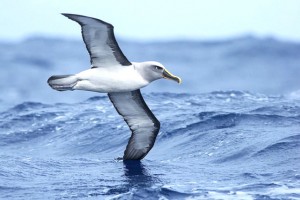Week 53 – 16 July 2017:
The Positive Impact of Harvest
Buller’s Albatrosses breed on small islands off the coast of New Zealand. With a global population of 32,000 breeding pairs, they are considered by the IUCN to be near-threatened. Some estimates show that numbers of these beautiful albatrosses are increasing, perhaps by as much as 3% per year. In an age of population declines, this seems like pretty good news. A recent publication by Susan Waugh at the Museum of New Zealand Te Papa Tongarewa in Wellington and her colleagues suggests that Buller’s Albatross may be getting assistance from a peculiar source.
Like the Buller’s Albatross, the Sooty Shearwater is a near-threatened seabird, but with a much larger global population. There are 180 Sooty Shearwater colonies in New Zealand alone, supporting approximately 4.4 million breeding pairs. Shearwater chicks, known as tītī, are harvested by some Māori groups, including members of the Ngai Tahu people. The harvest is considered an important component of the local culture, and helps to maintain social cohesion. Recent estimates have the harvest as high as 400,000 tītī each year.
How are the two seabird stories linked?
Waugh et al. reported on their observations of Buller’s Albatross at a large breeding colony at Solander Island. Fifty nests were monitored on the remote and uninhabited island. They also reported on the movements of seventeen albatrosses that had been fitted with GPS loggers. With regards to Sooty Shearwaters, interviews were conducted with three muttonbirders – the name given to individuals that harvest tītī. The harvest occurs at night. Bodies are processed the next day, and the non-edible parts are discarded into the sea. The traditional Māori harvest results in discarded material of between 78 and 120 tonnes each year.
The GPS loggers demonstrated that the albatrosses flew very long distances in search of food for their chicks, particularly over the Foveaux Strait off the south coast of New Zealand’s South Island. Curiously, several of the albatrosses were tracked to regions close to muttonbirding sites, including one bird that visited five such sites. Furthermore, the remains of tītī were found at five albatross study nests. These items had been rejected by the young albatross, and included heads, feet and feathers. “It is likely that a greater portion of chicks were fed soft parts of tītī over the two-month harvest period in April and May,” wrote Waugh et al.
On a global basis, pelagic seabirds are among the most threatened of all avian groups. The harvest of young Sooty Shearwaters is recognized as having an important role in maintaining local Māori traditions. It may also have an important role in maintaining populations of Buller’s Albatross.
Waugh, S. M., T. A. Poupart, C. M. Miskelly, J.-C. Stahl and J. P. Y. Arnould. 2017. Human exploitation assisting a threatened species? The case of muttonbirders and Buller’s Albatross. PLOS One https://doi.org/10.1371/journal.pone.0175458.
Photo credits: A Buller’s Albatross off the coast of New South Wales, Australia, credit@Leoviaflickr - thejupital.com/hooked-on-the-albatross; Sooty Shearwater stamp - colnect.com



